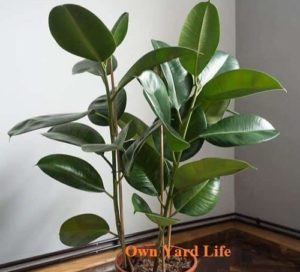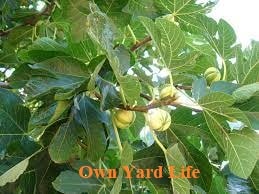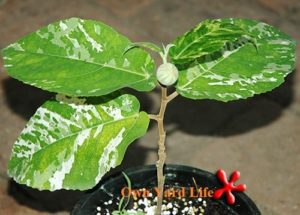You might be curious about other types of ficus trees after owning a fiddle leaf fig tree. There are over 850 species of trees, shrubs, and vines in the genus Ficus, ideal for indoor and outdoor ornamentals.
These ficus varieties have similar care and maintenance. But choosing the right type for your indoor or outdoor space can be a daunting experience. Our guide provides detailed insight into different kinds of ficus with their care routines.
Different Types of Ficus Trees and Plants
Most types of ficus trees grow well in an outdoor environment. But other species suit the indoor space as houseplants. (Source: University of Florida). Here is a list of 20 ficus varieties for indoor and outdoor environments:
Indoor Ficus Trees and Plants
If you’re looking to create a tropical feeling in your indoor space, below is a list of 10 common indoor ficus trees and plants:
Audrey Ficus

Audrey ficus is also called the Banyan tree or Indian Banyan. The ficus species is native to India and requires less maintenance routine.
The ficus tree has dark green leaves with light veins and grows through the cracks of host trees in its natural habitat. The tree has great cultural significance among Indians.
These small indoor ficus trees prefer bright indirect sunlight and well-draining soil to thrive well. The ficus tree can grow up to 10ft tall and its leaves are toxic if ingested.
If the tree is grown outdoors, it can reach enormous heights with invasive roots. We recommend planting outdoor Audrey ficus near your property.
Scientific Name |
Ficus benghalensis |
Maximum Height |
10ft tall |
USDA Zone |
11 |
Fiddle-Leaf Fig

It is among the most popular houseplant in the United States of America. It has large green leaves that bring tropical vibes to the indoor space.
The violin-shaped leaves and deep glossy green color help differentiate the species from other types of ficus plants. The slow-growing ornamental ficus can reach 9.8ft tall.
The outdoor counterpart has a bushy appearance and can grow up to 50ft tall. The houseplant is not ideal for beginners since it is fussy and challenging to maintain.
Scientific Name |
|
Maximum Height |
9.8ft |
USDA Zone |
10-12 |
Narrow-Leafed Fig

The narrow-leafed fig is also called the banana fig, Alii ficus, or Banana-leaf ficus. It is a perfect ficus species for growing in an indoor space.
The evergreen plant has long stems and leaves that create a bushy appearance. The long drooping leaves make an attractive accent in the house.
The average height for a narrow-leafed fig is about 10ft and requires regular pruning to keep the height much shorter. The plant requires bright indirect sunlight and moist soil.
Scientific Name |
Ficus maclellandii ‘Alii’ |
Maximum Height |
10ft tall |
USDA Zone |
10-12 |
Rubber Plant

It is a popular leafy indoor plant due to its ease of growing and maintenance. The rubber plant is also called the good luck plant according to Feng Shui.
The ficus tree has large dark green leaves with maroon veins and reddish-brown green edgings. The plant has an average height is about 8ft when grown indoors.
The evergreen houseplant needs bright indirect sunlight and well-draining soil to thrive well. We recommend planting them in pots or containers to restrict their growth rate.
Scientific Name |
Ficus elastica |
Maximum Height |
8ft |
USDA Zone |
9-11 |
Weeping Fig

It is another popular indoor ficus plant with small green shiny leaves and a bushy appearance. It grows to form a small shrub-like tree for ornamental purposes.
The thin flexible trunk can be trained to grow in the desired direction and shape. We recommend braiding the trunk to make your indoor space pop.
The weeping fig prefers indirect sunlight, moderate watering, and well-drained soil. The compact shape makes the ficus species suit tight spaces.
Scientific Name |
Ficus benjamina |
Maximum Height |
3-6ft |
USDA Zone |
10-12 |
Creeping Fig

It is a woody creeping ficus vine that thrives both indoors and outdoors. The small heart-shaped leaves and fast climbing growth are the distinctive features for recognition.
You can grow creeping figs in pots or containers to allow the leaves to dangle down and create a jungle vibe at home. Be sure to use a moss pole for supporting the houseplant.
Creeping figs flourish under bright indirect sunlight and well-drained soil that never gets dry. This ficus climbing vine can be a perfect ground cover in shady areas.
Scientific Name |
Ficus pumila |
Maximum Height |
8-13ft tall |
USDA Zone |
9-11 |
Ficus Daniella

It is another ficus variety that can adapt to both indoor and outdoor environments. It has thick oval-shaped waxy leaves for creating tropical jungle vibes.
The plant needs bright indirect sunlight, a humid environment, and moist soil that never gets soggy. Proper care will help prevent the leaves from falling off or turning brown.
Scientific Name |
Ficus Moclame |
Maximum Height |
6ft tall |
USDA Zone |
10-11 |
African Fig Tree

It is a small tree or shrub that clings to other trees in its natural habitat. The African fig trees are native to the African tropical forests.
The ficus tree can also be grown indoors since it can adapt to the environment. The slender stems with ovate leaves peppering create a bushy appearance.
African fig trees prefer bright indirect sunlight, average humidity, and moist soil that never gets soggy. Keep the plant away from pets and kids since leaves are toxic.
Scientific Name |
Ficus cyathistipula |
Maximum Height |
6-8ft |
USDA Zone |
13 |
Red Leaf Fig

The red leaf fig is native to Indonesia, Australia, Papua, and the Philippines. The tropical tree thrives near the stream and creek beds in its natural habitat.
The ficus tree has vibrant green leaves and sprout branches in an alternate form to look like a rosette. Juvenile foliage has a reddish-orange and coppery coloring.
Growing and caring for this ficus species can be challenging for beginners. But ensure the tree gets high humidity, bright indirect sunlight, and a moderate watering routine.
Scientific Name |
Ficus congesta |
Maximum Height |
50ft |
USDA Zone |
10-11 |
Retusa Bonsai

Retusa bonsai is a unique type of ficus tree that hails from Indonesia (Malay Archipelago region). The tree can grow up to 30ft tall in its natural habitat.
Indoor ficus retusa grows up to 1-3ft tall since it is a miniature bonsai tree. It is easy to grow and requires minimal pruning for maintaining its appearance.
We recommend placing this miniature bonsai tree in a spot with bright indirect sunlight and moderate to high humidity.
Keep the plant away from pets and toddlers since the leaves or bark are poisonous if ingested. Be sure to water the plant every two weeks when 2-3 inches of topsoil is dry.
Scientific Name |
Ficus retusa |
Maximum Height |
1-3ft |
USDA Zone |
10b-11 |
Outdoor Ficus Trees and Plants
Outdoor ficus trees come in different varieties with similar care and maintenance. Here is a list of 10 outdoor ficus trees and plants to consider:
Sacred Fig

It is a fast-growing fig tree suitable for warm outdoor environments. The heart-shaped leaves are the distinctive features of sacred fig trees.
This ornamental tree requires ultimate care to mark a bold statement in your garden or yard. The sacred fig tree thrives in full sunlight and can tolerate drought for a short time.
We recommend pruning the tree in the winter and spring to manage its height. Keep your pets and kids away from the tree since the leaves or bark can be poisonous.
Scientific Name |
Ficus religiosa |
Maximum Height |
98ft tall |
USDA Zone |
10-12 |
Common Fig

It is an ornamental ficus tree grown in temperate climate regions. The common fig tree is native to Middle Eastern and Mediterranean countries.
These fig trees are known for their delicious fig fruits and provision of good shelter in the garden. The brown Turkey and Chicago Hardy are cultivars ideal for cooler climates.
Scientific Name |
Ficus Carica |
Maximum Height |
10-30ft tall |
USDA Zone |
5-11 |
Indian Laurel

The ficus tree species is native to Asia and Australia due to the tropical climate. The ornamental tree needs pruning to manage the height and provide shade in the garden.
The tree has sturdy stems and heart-shaped leaves that resemble large green glossy balls. Indian laurel is also a type of bonsai ficus miniature tree.
Scientific Name |
Ficus microcarpa |
Maximum Height |
65ft tall |
USDA Zone |
9 to 11 |
Mistletoe Fig

It is a ficus perennial tree with thick waxy delta-shaped leaves suitable to warm climate environments. The tree is suitable as a ground cover since it has a spreading trait.
This focus shrub-like tree can also make an excellent houseplant since it can adapt to indoor conditions. It can grow up to 6.5ft tall and produce tiny red figs in the sunshine.
Scientific Name |
Ficus deltoidea |
Maximum Height |
6.5ft tall |
USDA Zone |
11 |
Ficus Ginseng

The focus ginseng tree is native to the South and Eastern part of Asia. The chubby trunk that resembles a pot belly is a distinctive feature.
The ficus tree flourishes in a hardiness zone from 9 to 11. But if you live in cooler climates, keep your ficus ginseng indoors.
Outdoor ficus ginseng requires minimal care routine compared to its indoor counterpart. Keep your indoor ficus ginseng in warm spots with bright indirect sunlight.
Scientific Name |
Ficus microcarpa |
Maximum Height |
3-4ft tall |
USDA Zone |
9-11 |
Clown Fig Tree

It is a fast-growing ficus tree with alluring leaves due to the multiple shades of green color. The clown fig trees are suitable for creating a beautiful hedge in your garden.
These trees do not thrive in cooler climates since their hardiness zone range from 10a and 11. But you can convert them into houseplants to enjoy the tropical jungle vibes.
Plant your clown fig trees in a spot with partial shade since young trees love bright indirect sunlight. Keep the tree away from kids and pets since the fruits are inedible.
Scientific Name |
Ficus aspera parcelli |
Maximum Height |
20ft tall |
USDA Zone |
10a – 11 |
Sandpaper Fig

The sandpaper fig is native to Australia and can grow all over the world. But the ficus tree thrives in moist environments.
These ficus trees grow well along the river banks and rainforests to reach 20-39ft. You can also grow these trees in a pot or container as houseplants.
The dark brown trunk and ovate leaves create a stunning appeal in the garden. The tree also produces edible fruits and needs regular pruning to manage its height.
Scientific Name |
Ficus coronata |
Maximum Height |
20-39ft tall |
USDA Zone |
8-11 |
The Curtain Fig

It is an evergreen tree suitable for the backyard since it will make your home appear more stylish. The evergreen ficus tree hails from China and can thrive in Mediterranean areas.
The tree can grow up to 160ft and spread about 200ft wide to create the best shade in the yard. It requires rigorous pruning to maintain shape and manage the height.
This ornamental tree is ideal for large yards and is easy to grow. If you dwell in a region that receives plenty of sunlight, the tree might not survive for a longer period.
Scientific Name |
Ficus microcarpa |
Maximum Height |
160ft tall |
USDA Zone |
9-12 |
Sycamore Fig

The sycamore fig is native to Africa and can also be grown in the Middle East. It is suitable for both indoor and outdoor environments.
The ficus species require a lot of rain though it can tolerate a short period of drought. Be sure to grow your sycamore fig in well-draining soil.
The tree is winter resistant and provides good shade in the summer. Easy to grow and maintain among beginners.
Scientific Name |
Ficus sycomorus |
Maximum Height |
65ft tall |
USDA Zone |
4-9 |
Long Leaf Ficus Tree

It is an evergreen ficus tree that thrives outdoors in tropical climates. It grows tall and lush to provide shade in the yard.
Outdoor long-leaf ficus trees can grow up to 100ft tall and require regular pruning to manage the height. The lush and attractive leaves create a tropical jungle feeling.
Scientific Name |
Ficus binnendijkii |
Maximum Height |
100ft tall |
USDA Zone |
10 |
Related Articles:






